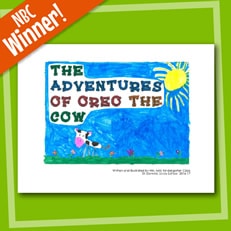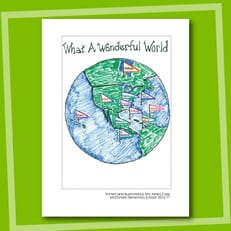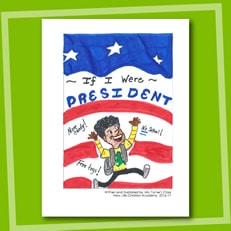 Growing up, my favorite teachers were the ones whose classrooms I walked out of feeling motivated to do something—usually something creative, like drawing or writing about whatever I’d learned that day. One English teacher in particular inspired me to become the person I am today—a writer, a dreamer and, of course, an educator.
Growing up, my favorite teachers were the ones whose classrooms I walked out of feeling motivated to do something—usually something creative, like drawing or writing about whatever I’d learned that day. One English teacher in particular inspired me to become the person I am today—a writer, a dreamer and, of course, an educator.
I’m not the only one, either. Stories like The Freedom Writers Diary, The Dead Poets Society, and The Priority List are just a few examples of how, both in real life and in the world of fiction, teachers can inspire their students to pursue their passions and achieve great things. It all starts with a lesson plan that opens up your students’ minds and gets them to see things in a new light. These creative writing activities for elementary students are all about inspiring your kids to think big—and dream bigger.
 Writing Activity #1: Seeking Adventure
Writing Activity #1: Seeking Adventure
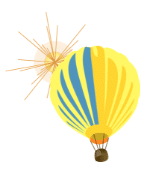 There’s no better writing fodder for elementary students than the prospect of adventure. What kid hasn’t dreamed of embarking on an epic journey to lands unknown? Inspire a sense of adventure in your students with an open-ended prompt like, “Imagine you’ve just come back from an exciting adventure. Describe what happened,” and let them run with it. Not only are the responses inevitably as much fun to read as to write, but this is a particularly good way to introduce very young elementary students to narrative writing practice.
There’s no better writing fodder for elementary students than the prospect of adventure. What kid hasn’t dreamed of embarking on an epic journey to lands unknown? Inspire a sense of adventure in your students with an open-ended prompt like, “Imagine you’ve just come back from an exciting adventure. Describe what happened,” and let them run with it. Not only are the responses inevitably as much fun to read as to write, but this is a particularly good way to introduce very young elementary students to narrative writing practice.
PROJECT IDEA
Mrs. Mills’s kindergarten class turned this idea into a very special class project by combining their writing with a lovely act of charity. After adopting a cow through a local Dairy Council program, the students wrote, illustrated and published a collection of short stories about fantastical (fictional!) adventures with their cow, who they named Oreo. They wrote about everything from jungle expeditions to Disney World vacations—even traveling all the way up to the North Pole!
The Adventures of Oreo the Cow by Mrs. Mills’ kindergarten class
 Writing Activity #2: Pursuing Dreams
Writing Activity #2: Pursuing Dreams
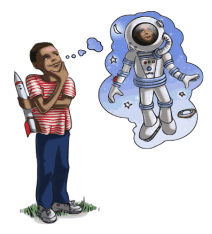 Most kids probably don’t know exactly what they want to be when they grow up. I know my “dream job” in elementary school changed weekly and ranged from astronaut to acrobat and everything in between. But that doesn’t mean it’s too early to get your kids into the habit of thinking about the future—and what better way to do so than through an enriching creative writing exercise? Asking your students to write about their dream jobs can be an excellent opportunity to help them practice using different research tools, hone their critical thinking skills, or simply inspire them—not only to consider their dreams in depth, but to begin figuring out how to make them come true.
Most kids probably don’t know exactly what they want to be when they grow up. I know my “dream job” in elementary school changed weekly and ranged from astronaut to acrobat and everything in between. But that doesn’t mean it’s too early to get your kids into the habit of thinking about the future—and what better way to do so than through an enriching creative writing exercise? Asking your students to write about their dream jobs can be an excellent opportunity to help them practice using different research tools, hone their critical thinking skills, or simply inspire them—not only to consider their dreams in depth, but to begin figuring out how to make them come true.
PROJECT IDEA
The students of Mrs. Dekker’s class at John J. Montgomery Elementary School turned this creative writing activity into a work of art by publishing their dreams for the future in a beautiful classbook. Titled Believe in Yourself and Your Dreams, their book emphasizes the importance not only of dreams, but in having the self-confidence necessary to realize them.
Believe in Yourself and Your Dreams by Mrs. Dekker’s Class
 Writing Activity #3: Broadening Horizons
Writing Activity #3: Broadening Horizons
 Travel has many proven benefits for the young and the old alike, including boosting creativity, reducing stress, increasing emotional stability, and generally making us happier. While field trips are one way to achieve these results, reading and writing offer a more affordable alternative—one you and your students can take advantage of whenever you like, without ever having to set foot outside of the classroom. Broaden your students’ horizons by offering up a prompt that lets them travel—mentally, if not physically—to the places they’ve always dreamed of visiting, or have visited in the past and wish to return to. It’s the perfect way to practice a little descriptive writing while inspiring your students to seek new experiences and explore unfamiliar places and cultures.
Travel has many proven benefits for the young and the old alike, including boosting creativity, reducing stress, increasing emotional stability, and generally making us happier. While field trips are one way to achieve these results, reading and writing offer a more affordable alternative—one you and your students can take advantage of whenever you like, without ever having to set foot outside of the classroom. Broaden your students’ horizons by offering up a prompt that lets them travel—mentally, if not physically—to the places they’ve always dreamed of visiting, or have visited in the past and wish to return to. It’s the perfect way to practice a little descriptive writing while inspiring your students to seek new experiences and explore unfamiliar places and cultures.
PROJECT IDEA
What a Wonderful World, published by students of Mrs. Kline’s class at McDonald Elementary School, exquisitely exemplifies how this creative writing activity can be turned into a fantastic class project. These young authors coupled full-color illustrations and detailed research with descriptive, sometimes even narrative, writing elements to bring their favorite destinations to life. The result? An eye-catching classbook sure to inspire not just the authors themselves, but fellow students in other classrooms and schools as well.
What a Wonderful World by Mrs. Kline’s Class
 Writing Activity #4: Imagining Change
Writing Activity #4: Imagining Change
 “Children of today,” as Nelson Mandela said, “are the leaders of tomorrow.” Whether they realize it yet or not, your students possess incredible potential to change the world. Encourage them to harness this power for good by asking them to write about the ways in which they could enact positive change if they were in a position of power. As the leaders of tomorrow, what issues will be most important to them? What problems will they focus on solving first?
“Children of today,” as Nelson Mandela said, “are the leaders of tomorrow.” Whether they realize it yet or not, your students possess incredible potential to change the world. Encourage them to harness this power for good by asking them to write about the ways in which they could enact positive change if they were in a position of power. As the leaders of tomorrow, what issues will be most important to them? What problems will they focus on solving first?
PROJECT IDEA
Mrs. Turner’s future leaders went straight to the source when publishing their responses to this writing activity by describing what they would each do if they became President of the United States. Despite their youth, their answers reflect quite a mature sense of empathy for a wide range of social issues. Equally as important, there’s a sense of hope throughout the book, starting with the inspirational message Mrs. Turner herself wrote in the introduction:
“There are no limits to what you can achieve. You can be President, an astronaut, a doctor, an engineer, a teacher, etc. Work hard, stay on track, and NEVER lose sight of your dreams. If you can believe, you can achieve.”
If I Were President by Mrs. Turner’s Class
Using the Writing Process to Inspire Your Students
A good writing exercise, whether about adventure, dreams, travel or the future, is one of the most effective tools in a teacher’s toolbox for channeling children’s creative energy into doing something productive and meaningful. But the lesson doesn’t have to end with the last word on the page! While writing itself is an excellent educational exercise, walking your students through the full process of both making and publishing creative work can be the key to making a good lesson great, and that much more memorable.
Plus, as illustrated with the examples above, when you help your students become published authors, you’re not just inspiring them to believe in themselves and be proud of a job well done. You might also inspire other teachers like yourself to give their students the same fantastic opportunity.
For more writing activities, lesson plans and other teaching and publishing resources, check out our online teacher’s lounge, and sign up for your free publishing kit today!
Image sources: Lead image via Shutterstock; Images 1, 2, 3, 4 via Openclipart.org






